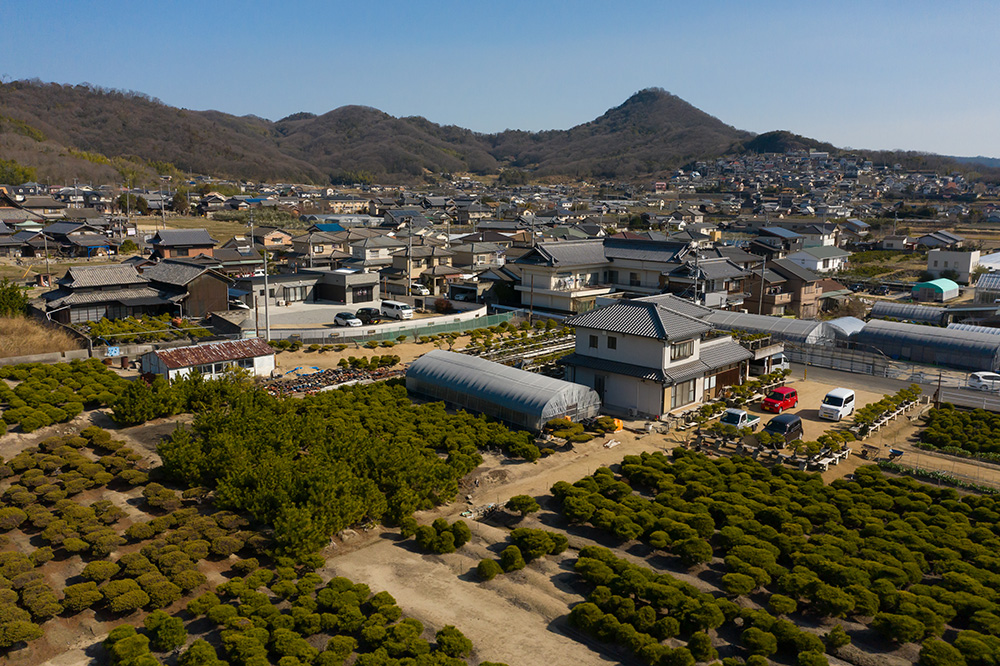What is Takamatsu bonsai technical training?
- HOME
- What is Takamatsu bonsai technical training?
We started Bonsai no Takumi, Takamatsu bonsai technical training, in January 2020 to share bonsai techniques and develop the next generation of bonsai enthusiasts and professionals.
It is a training program that enables students to learn skills directly from bonsai artisans in a historic bonsai tree-producing place in Takamatsu, Kagawa.
Takamatsu Bonsai is characterized by its use of shohaku (evergreen needle-leaved trees such as black pine, Japanese black pine, Chinese juniper, and Japanese white pine). Students learn the basics of how to care for bonsai trees, and the program flexibly adapts to students' levels.
If you are a proficient- or intermediate-level bonsai enthusiast, this program will help you improve your skills. This program will even aid young professional bonsai artisans in their continuing training. We welcome beginners who have just begun growing bonsai trees in addition to intermediate and advanced enthusiasts.
Overseas bonsai lovers and teachers have often visited Japan for technical training at bonsai gardens in Takamatsu, Kagawa because of the increasing number of bonsai trees exported and the increasing popularity of bonsai in other countries.
Bonsai no Takumi features accommodations for domestic and overseas trainees who wish to learn bonsai techniques for short or extended periods.
Bonsai has become a hobby that is loved by a small number of enthusiasts, as its prominence in peoples lives has gradually waned over its long history.
The hope is that Takamatsu bonsai technical training will give people the opportunity to rediscover bonsai and Japanese culture, and draw the interest in bonsai of people of all generations.
What is Takamatsu bonsai?
The Kinashi and Kokubunji districts in Kagawa are Japan's greatest pine bonsai tree producing places.
The bonsai trees grown in these districts are called Takamatsu bonsai.
The long history of Takamatsu bonsai is traceable back to the late Edo Period when they transplanted charming pine trees grown naturally in mountains or on islands into pots, creating bonsai trees. The warm, semiarid climate and the well-drained soil of Takamatsu, Kagawa are suitable for the cultivation of pine trees. Bonsai trees from Takamatsu are highly valued on the market because it is difficult for their roots to rot, and the trees are strong.
There are about 60 bonsai gardens in Kinashi and Kokubunji, ranging from producers who grow trees by grafting them to rootstock to the artisans who elevate bonsai to art. Bonsai has taken root in the lives of the people in the areas where bonsai fields and residential areas still exist alongside each other.
Bonsai events
There are many bonsai-related events in the Takamatsu bonsai region.
- Takamatsu Bonsai no Sato spring festival
- Bonsai & Garden Trees Festival in Kinashi
- Takamatsu-Bonsai-no-Sato Fest
The facilities associated with bonsai

Takamatsu Bonsai no Sato
50 bonsai gardens in Kinashi and Kokubunji have facilities for exhibiting and selling bonsai trees offered. Over 10,000 shohaku and zoki trees are kept there.
Bonsai garden hopping
Many of the bonsai gardens allow visitors to tour their gardens in Kinashi and Kokubunji.
You are able to buy the bonsai trees that call out to you.
Hiramatsu Syunsyoen
Hiramatsu Syunsyoen is a bonsai garden founded during the Meiji Period. Operated by fourth-generation owner HIRAMTSU Koji, it organizes Takamatsu bonsai technical training. In their bonsai garden, there are many bonsai trees including the shohaku evergreen needle-leaved trees such as black pine, Chinese juniper, and Japanese white pines.
Hiramatsu Syunsyoen is one of Japan's leading bonsai gardens, dealing in a range of sizes from small trees that are only as high as 20 cm to large trees. HIRAMTSU Koji is widely known for his incredible skill inside and outside Japan. He is invited by the the World Bonsai Convention's executive committee to demonstrate on stage at the convention.
